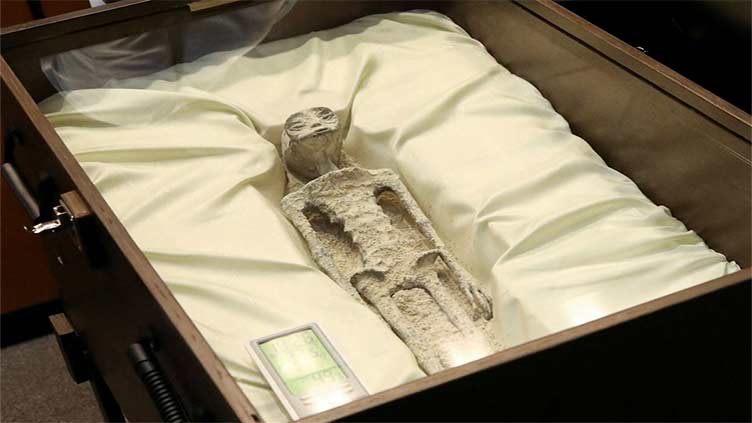'Alien bodies' presented in Mexican Congress panned as 'stunt' draw international backlash

World
Similar such finds in the past have turned out to be the remains of mummified children
MEXICO CITY (Reuters) – A UFO hearing in Mexico's congress that featured the presentation of alleged remains of non-human beings faced swift international backlash on Thursday, with critics labeling it a "stunt," and questions from officials in Peru, where the apparent specimens first emerged.
Mexican journalist and long-time UFO enthusiast Jaime Maussan showed politicians at the hearing on Tuesday two tiny "bodies" displayed in cases, with three fingers on each hand and elongated heads. He claimed they were found in Peru in 2017 and were not related to any life on Earth.
Maussan has made similar controversial claims in the past.
The images from the congressional hearing, the first of its kind in Mexico, sparked international curiosity as well as substantial scorn.
Former US Navy pilot Ryan Graves, who also attended the hearing to share his personal experience with sightings of "unidentified anomalous phenomena," or UAP, heaped criticism on the presentation.
"Yesterday's demonstration was a huge step backwards for this issue," Graves said on the X social media platform, formerly known as Twitter. "I am deeply disappointed by this unsubstantiated stunt."
Graves participated in US Congressional hearings on UAP in July, when he said that airspace sightings of unexplained phenomena were "grossly under-reported."
Maussan said in the presentation that the specimens were recovered near Peru's ancient Nazca Lines and had been carbon-dated by Mexico's National Autonomous University (UNAM) and concluded to be about 1,000 years old. He claimed they were not related to any species on Earth.
Similar such finds in the past have turned out to be the remains of mummified children.
Peruvian Culture Minister Leslie Urteaga said no scientific institution in the South American country had identified the remains as non-human and questioned how the specimens had left Peru.
"There is a criminal complaint from the Ministry of Culture against some people who had a relationship with these gentlemen," Urteaga told journalists late on Wednesday in reference to Maussan and his associates.
"I am going to ask for information to see what has happened ... about the removal of pre-Hispanic objects, because I understand they are part of pre-Hispanic bone remains," she added.
Maussan, speaking to Reuters on Thursday, said his critics had yet to present evidence to counter his claims.
"What they want is to take away the force that this discovery has, but only with testimonies, with questioning and without a single piece of evidence," Maussan said. "We have been doing investigations for years... they want to come here to investigate with just talk."
UNAM, in a statement republished on Wednesday that it first issued in 2017, said the work by its National Laboratory of Mass Spectrometry with Accelerators (LEMA) was only intended to determine the age of the samples. UNAM declined a request by Reuters to see the full study results or interview researchers who participated. It also declined to say how old its study had found the samples to be.
In a press conference on Thursday, NASA officials fielded questions about the Mexican presentation as they released their own report on recommendations for helping the Pentagon detect and examine UAP.
David Spergel, former head of Princeton University's astrophysics department and chair of the report, said he did not know the nature of the samples but urged transparency.
"If you have something strange, make samples available to the world's scientific community, and we'll see what's there," he said.


